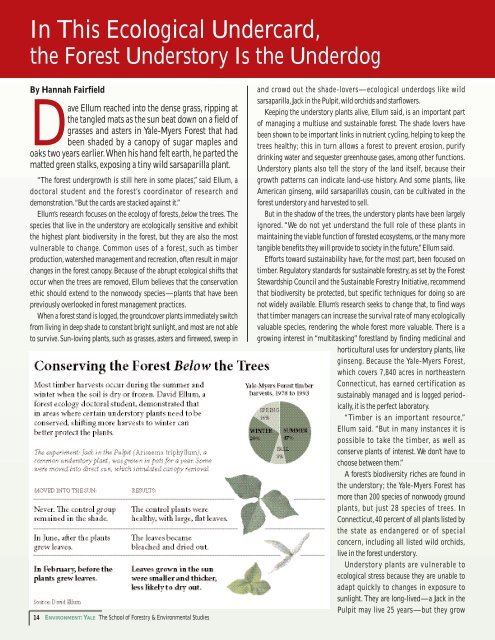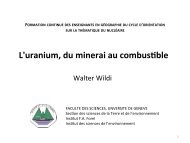As a Remedy to Global Warming, As a Remedy to Global Warming
As a Remedy to Global Warming, As a Remedy to Global Warming
As a Remedy to Global Warming, As a Remedy to Global Warming
You also want an ePaper? Increase the reach of your titles
YUMPU automatically turns print PDFs into web optimized ePapers that Google loves.
In This Ecological Undercard,the Forest Unders<strong>to</strong>ry Is the UnderdogBy Hannah FairfieldDave Ellum reached in<strong>to</strong> the dense grass, ripping atthe tangled mats as the sun beat down on a field ofgrasses and asters in Yale-Myers Forest that hadbeen shaded by a canopy of sugar maples andoaks two years earlier.When his hand felt earth, he parted thematted green stalks, exposing a tiny wild sarsaparilla plant.“The forest undergrowth is still here in some places,” said Ellum, adoc<strong>to</strong>ral student and the forest’s coordina<strong>to</strong>r of research anddemonstration.“But the cards are stacked against it.”Ellum’s research focuses on the ecology of forests, below the trees. Thespecies that live in the unders<strong>to</strong>ry are ecologically sensitive and exhibitthe highest plant biodiversity in the forest, but they are also the mostvulnerable <strong>to</strong> change. Common uses of a forest, such as timberproduction, watershed management and recreation, often result in majorchanges in the forest canopy. Because of the abrupt ecological shifts tha<strong>to</strong>ccur when the trees are removed, Ellum believes that the conservationethic should extend <strong>to</strong> the nonwoody species—plants that have beenpreviously overlooked in forest management practices.When a forest stand is logged, the groundcover plants immediately switchfrom living in deep shade <strong>to</strong> constant bright sunlight, and most are not able<strong>to</strong> survive. Sun-loving plants, such as grasses, asters and fireweed, sweep in14 ENVIRONMENT:YALE The School of Forestry & Environmental Studiesand crowd out the shade-lovers—ecological underdogs like wildsarsaparilla, Jack in the Pulpit, wild orchids and starflowers.Keeping the unders<strong>to</strong>ry plants alive, Ellum said, is an important par<strong>to</strong>f managing a multiuse and sustainable forest. The shade lovers havebeen shown <strong>to</strong> be important links in nutrient cycling, helping <strong>to</strong> keep thetrees healthy; this in turn allows a forest <strong>to</strong> prevent erosion, purifydrinking water and sequester greenhouse gases, among other functions.Unders<strong>to</strong>ry plants also tell the s<strong>to</strong>ry of the land itself, because theirgrowth patterns can indicate land-use his<strong>to</strong>ry. And some plants, likeAmerican ginseng, wild sarsaparilla’s cousin, can be cultivated in theforest unders<strong>to</strong>ry and harvested <strong>to</strong> sell.But in the shadow of the trees, the unders<strong>to</strong>ry plants have been largelyignored. “We do not yet understand the full role of these plants inmaintaining the viable function of forested ecosystems, or the many moretangible benefits they will provide <strong>to</strong> society in the future,”Ellum said.Efforts <strong>to</strong>ward sustainability have, for the most part, been focused ontimber. Regula<strong>to</strong>ry standards for sustainable forestry, as set by the ForestStewardship Council and the Sustainable Forestry Initiative, recommendthat biodiversity be protected, but specific techniques for doing so arenot widely available. Ellum’s research seeks <strong>to</strong> change that, <strong>to</strong> find waysthat timber managers can increase the survival rate of many ecologicallyvaluable species, rendering the whole forest more valuable. There is agrowing interest in “multitasking” forestland by finding medicinal andhorticultural uses for unders<strong>to</strong>ry plants, likeginseng. Because the Yale-Myers Forest,which covers 7,840 acres in northeasternConnecticut, has earned certification assustainably managed and is logged periodically,it is the perfect labora<strong>to</strong>ry.“Timber is an important resource,”Ellum said. “But in many instances it ispossible <strong>to</strong> take the timber, as well asconserve plants of interest. We don’t have <strong>to</strong>choose between them.”A forest’s biodiversity riches are found inthe unders<strong>to</strong>ry; the Yale-Myers Forest hasmore than 200 species of nonwoody groundplants, but just 28 species of trees. InConnecticut, 40 percent of all plants listed bythe state as endangered or of specialconcern, including all listed wild orchids,live in the forest unders<strong>to</strong>ry.Unders<strong>to</strong>ry plants are vulnerable <strong>to</strong>ecological stress because they are unable <strong>to</strong>adapt quickly <strong>to</strong> changes in exposure <strong>to</strong>sunlight. They are long-lived—a Jack in thePulpit may live 25 years—but they grow








